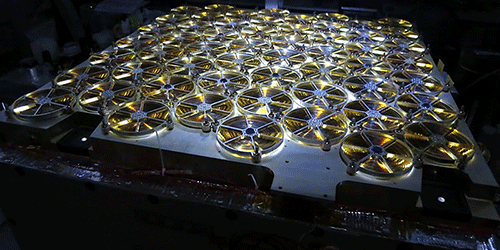Meetings: Interplanetary GPS
Humans have always navigated using the stars, and now NASA has taken that concept to a new level of precision. An x-ray telescope onboard the International Space Station demonstrated a navigation system based entirely on detecting the periodic x-ray emissions of certain neutron stars (pulsars). Keith Gendreau of the NASA Goddard Space Flight Center reported on the results at the American Astronomical Society meeting in Washington, DC, this month. The navigation system, called the Station Explorer for X-ray Timing and Navigation Technology, or SEXTANT, was able to locate the spacecraft to within 10 km. This level of accuracy is comparable with traditional navigation techniques for space probes in the outer Solar System, where signals from Earth’s radio telescopes are weak.
All US interplanetary probes rely on NASA’s Deep Space Network (DSN) of radio telescopes for navigation, as it can determine a probe’s distance from Earth with centimeter-scale accuracy. But the DSN is much less accurate for lateral distances, and its accuracy decreases with the distance from Earth. NASA would also like to reduce the heavy usage of the DSN and to develop an independent, autonomous navigation system that would provide redundancy, especially for future missions that may include humans.
The idea to use the exceedingly precise and predictable timing of pulsars for navigation has been around nearly since the discovery of pulsars 50 years ago. So-called millisecond pulsars emit pulses of radiation hundreds of times per second, and the arrival times of pulses can sometimes be predicted with microsecond precision for years into the future. This level of precision is similar to that of atomic clocks onboard the GPS satellites. These clocks provide a time-stamp with each signal sent from space, allowing a GPS receiver on Earth to find its location by comparing the arrival times of multiple satellite signals. With detailed knowledge of several pulsar frequencies and locations, a similar trick should work for spacecraft.
The SEXTANT mission uses software onboard an x-ray telescope called the Neutron star Interior Composition Explorer, or NICER, which is recording x rays emitted by neutron stars in order to learn more about these exotic objects. The arrival time of each x-ray photon is recorded with submicrosecond precision, making NICER an ideal test bed for pulsar navigation. During its first operation in November 2017, SEXTANT pointed the telescope sequentially at five different millisecond pulsars and determined the International Space Station’s position in less than the 1 to 3 days the team had planned for, said SEXTANT Project Manager Jason Mitchell. “We were pleasantly surprised to converge in less than 8 hours, which we attribute to the number of millisecond pulsars we were able to observe and to the excellent performance of the NICER instrument.” 8 hours is plenty of time for typical spacecraft guidance, he added.
Gendreau, who led the development of NICER, presented data showing that if you simply calculated the spacecraft’s position based on a starting location and velocity, the error would grow to tens of kilometers within days. SEXTANT was able to maintain a location error compared with GPS of less than 10 km, which is not a long distance when you’re traveling millions of miles, Gendreau said.
The SEXTANT team expects to bring the errors down below 1 km later this year, when they will have another chance to operate, and ultimately down to a few hundred meters—better than the DSN performs for the outer Solar System. However, “we don’t claim that [pulsar navigation] will replace current deep space navigation technology,” said SEXTANT team member Luke Winternitz. He explained that it will improve navigation by working alongside current techniques and by operating in situations where other systems are not available.
–David Ehrenstein
David Ehrenstein is the Focus Editor for Physics.





